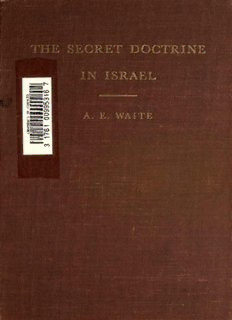
The Secret Doctrine in Israel - Hermetic Order of the Golden Dawn PDF
Preview The Secret Doctrine in Israel - Hermetic Order of the Golden Dawn
Presented to the LIBRARY of the UNIVERSITY OF TORONTO by the CANADIAN FOUNDATION for JEWISH CULTURE FELDHEIM S c THE SECRET DOCTRINE IN ISRAEL INAH THE SACRED TREE OF THE SEPHIROTH Frontispiece THE SECRET DOCTRINE IN ISRAEL A STUDY OF THE ZOHAR AND ITS CONNECTIONS BY ARTHUR EDWARD WAITE WITH FOUR ILLUSTRATIONS OCCULT RESEARCH PRESS Publishers 115 FOURTH AVENUE NEW YORK 3, N. Y. A PRINTED IN THE UNITED STATES OF AMERICA PREFACE IN the year 1902 I endeavoured in The Doctrine and Literature of the Kabalah to offer a consideration in detail of the chief texts which embody the Secret Tradition in Israel, together with some account of the manner in which it influenced Christian scholarship in Europe during the i6th, iyth and i8th centuries, or broadly speaking, from the period of Picus de Mirandula until the eve of the French Revolution. The publication of Sepher Ha Zohar, or The Book of Splendour, which is the palmary Kabalistic text, for the first time in another language than the original Chaldaic, took place in France between the years 1906 and I9H,1 thus putting into the hands of modern students the best means of judgment concerning the tradition at large. If there be not at the present day much that remains for our agreement in the very interesting literary monograph of Adolphe Franck, entitled La Kabbale* published in 1843 an<^ reprinted more recently, with some corrections, in 1892, I believe that I shall be in accord with all scholarship that deserves the name if I express my concurrence when he says that the later Kabalists, like Isaac de Loria, Abraham Cohen Irira et hoc genus omne, added mainly their personal reveries to that great text and enfeebled it precisely in proportion as they sought to develop and reduce it into 1 SEPHER HA ZOHAR (Le Ltvre de la Splendeur): Doctrine soterique des Israelites. Tradnit pour la premierefois sur le texte Chaldaique et accompagni de notes, par JEAN DE PAULY. (Euvre posthumeentierementrevue,corrigeeetcompletee. Publieeparlessoinsde EMILE LAFUMA-GIRAUD. 6 vols. 1 La Kabbale, ou La Philosophic Religieuse des Hbreux. Par Ad. Franck. The Secret Doctrine in Israel a system of the conventional kind. I am concerned in the present study with few questions belonging to purely critical scholarship, but in these prefatory remarks a word must be said upon the Zohar in respect of its authority or otherwise on the question of date not indeed with the view of discussing, much less of deter mining so difficult a question, but to shew in the interests of clearness that such a question exists. The text itself belongs to a period in literature which knew nothing of chronological importance and still less of the values attaching to personalities in authorship. It is anonymous in respect of its redaction and it is silent as to the circumstances under which and the imputed time of the world when it came into the ever growing circle of Jewish records. By its hypothesis, however, it is an account of discourses between Rabbi Simeon Ben Jochai and other masters of the mystic understanding of the Law and the Prophets, of whom he was leader and chief.1 This is the first point of the hypothesis. In respect of the second and last point, it is a record of the debates which took place between certain immediate successors of Rabbi Simeon, who belongs by tradition to the first century of the Christian era, or the period of the destruction of Jerusalem by Vespasian, A.D. 70. I put aside in this connection various texts and extracts or fragments of texts which are, as one may say, imbedded in the Zohar, introduced for the most part at arbitrary points, where they have little or no relation to that which precedes and comes after. It is to this that we owe the preservation of certain parts of a work entitled Sepher Ha Bahir, or Book of Brightness. Their authority has been disputed, but there seems good ground for believing (i) that if the Zohar proper is a work of the early Christian 1 It should be observed that he is the traditional author ofthe text itself, subject, I suppose, to exceptions in respect of those parts which either give account of his death or of what transpired among his successors after that event. VI
Description: